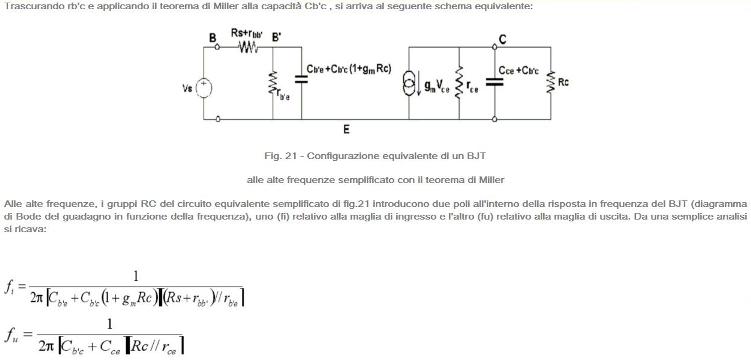|
Note: You must be registered in order to post a reply.
To register, click here. Registration is FREE!
|
| Legolas81 |
Posted - 02/12/2007 : 22:23:50 |
Ciao, qualcuno mi spiegherebbe il motivo fisico per il quale in un amplificatore ad emettitore comune con carico cortocircuitato (Vce=0) la frequenza fT (in corrispondenza della quale, il guadagno di corrente vale 1) diminuisce con l'aumentare di ic per alti valori della corrente di collettore?
Grazie |
| wasm |
Posted - 02/19/2007 : 20:42:06 |
Non sono un esperto di bipolari indi vi riporto quello che dice Bahl a riguardo
Limitations and Second-Order Effects
There are several effects that limit the operation of bipolar transistors to restricted ranges of applied bias. These effects are examined in this section.
Collector Bias Variation (Early Effect).
A changing collector-base bias causes a variation in the space-charge layer width at the base-collector junction and, consequently, in the width of the bulk base region. Base-width modulation by the collector-base voltage is called the Early effect [6]. An increase in VcB reduces the base width, thereby increasing the gradient of the minority charge. A decrease in total minority charge in the base and an increase in collector current result. The base current is also decreased, since base current is proportional to base-charge storage.
Collector High-Injection Effects (Kirk Effect).
Free carriers entering the base-collector depletion region modify the background charge in that region and thereby affect the electric field. For a constant collector-base voltage the width of the depletion region changes to accommodate changes in the electric field. Under high injection the width of the depletion region tends to decrease, thereby increasing the effective neutral base region. This phenomenon is called the Kirk effect [7]. As the current increases, the neutral base region increases and the current gain is reduced. The Kirk effect can have a significant effect upon device performance, since the neutral base region can increase by a large factor under high-injection conditions. The base transit time can be significantly increased under high current injection due to the added base length. Under these conditions, the highfrequency performance of the transistor will be degraded.
Base-Region High-Injection Effects.
Under high-current-injection conditions, it is possible for the injected minority density in the base region to be on the same order of magnitude as the doping density. The large density of injected minority carriers causes an increase in majority carriers in order to satisfy charge neutrality conditions. The increase in majority carriers causes an effective increase in the base-region charge and a reduction in the alpha current gain. The reduction in alpha with Ic is known as the Webster effect  . .
|
| Legolas81 |
Posted - 02/13/2007 : 14:53:50 |
|
Ciao Antonio e grazie, per valori della corrente di collettore bassi sicuramente la componente dovuta alla diffusione della capacità fra B' ed E e' sovrastata dalle capacità di transizione del modello, quindi essendo gm l'unica grandezza proporzionale ad ic che ha un effetto rilevante (si trova inoltre al numeratore della espressione fT=gm /2*pi(Ce+Cc)) non puo' che provocare un aumento di ft per le ic crescenti. Man mano che la corrente aumenta la capacità di diffusione di cui sopra inizia a farsi sentire ed è in grado (entro un certo range) di bilanciare gli incrementi di ic (si ha una zona con fT costante rispetto ad ic). Il problema è per le ic alte!!! Molti libri, tipo Millman e Sedra Smith, dichiarano che il fenomeno fisico per il quale si verifica il comportamento di cui stiamo parlando esula dagli scopi del testo. Leggendo la tua risposta penso che quello che mi hai scritto possa essere una spiegazione plausibile, infatti per alte correnti la capacità del circuito di ingresso continua ad aumentare e conseguentemente aumenta la costante di tempo e diminuisce la frequenza di taglio superiore!!!! ANTO' MI HAI FATTO ARRIVARE AD UN POSSIBILE MOTIVO SEI UN GRANDEEEEEEEEEEE GRAZIE |
| etantonio |
Posted - 02/13/2007 : 00:02:38 |
OK Giovanni,
provo a sbagliare, tu correggimi 
Allora, se il circuito di Giacoletto per l'emettitore comune è questo :

e considerando la sola frequenza di taglio della maglia di ingresso in quanto inferiore a quella della maglia di uscita .
Per Rc = 0 la dipendenza è solo dalle resistenze e capacità che coinvolgono la base del transistor, e sono a denominatore quindi un loro aumento riduce la frequenza di taglio.
Un aumento della Ic probabilmente è conseguenza di un restringimento della regione di base e pertanto di un aumento delle due resistenze di base o quantomeno della Rbb.
Che dici, di quanto stò fuori ???
|
|
|
|
|
|
|
|

